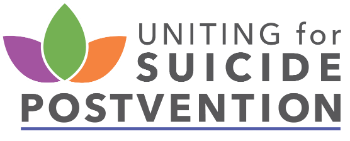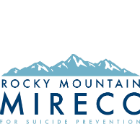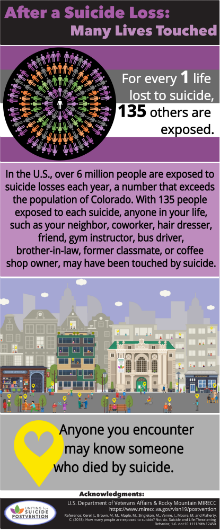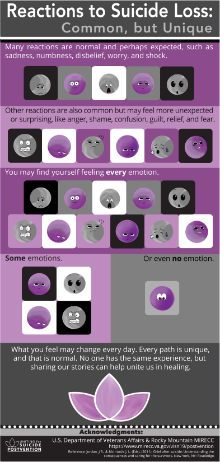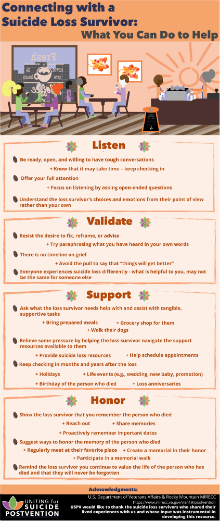MIRECC / CoE
Uniting for Suicide Postvention - Understanding Suicide Loss
Community Pages: Understanding Suicide Loss | Voices of Other Loss Survivors | Additional Resources
It is common for family members and friends to experience changes in their social, emotional, and physical functioning after the suicide death of someone they know. This USPV section provides an overview of the impact of suicide loss, common reactions during suicide-specific bereavement, and ways to support suicide loss survivors.
After a Suicide Loss: Many Lives Touched
This infographic provides a visual representation of the expansive impact of suicide loss. Historically, it was believed that approximately six people were exposed to any given suicide loss. Now, we know that exposure to suicide loss is much more widespread as 135 people are touched by a single suicide (Cerel, 2018). This means that the impact of suicide loss extends beyond just close family members and friends—neighbors, coworkers, former classmates, and even your local coffee shop barista likely know someone who has died by suicide.
Download PDF of After a Suicide Loss: Many Lives Touched.
Podcast: Postvention 101
Check out the “Postvention 101” podcast to hear Dr. Jack Jordan lay a foundation for understanding what suicide postvention is, what it entails, who it is for, and why it is essential to a comprehensive suicide prevention plan. Jack Jordan, PhD is a clinical psychologist, grief therapist and published researcher in the field.
Listen to the podcast:
Visit the website for supporting material
Reactions to Suicide Loss: Common but Unique
This infographic can be a helpful tool for those who are experiencing grief following the suicide loss of someone they knew. Common reactions to a suicide loss include feelings of sadness, disbelief, anger, guilt, and shock. However, everyone’s reaction is unique and can include any combination of these emotions—or perhaps none. If you want to support someone who is experiencing a loss and don’t know where to start, consider downloading this graphic and printing it out for them to reference as they move through their individual grieving process.
Download PDF of Reactions to Suicide Loss: Common but Unique.
Connecting with a Suicide Loss Survivor: What You Can Do to Help
If someone you know has lost a loved one to suicide, it can be particularly difficult to know when and how to step in and help. This infographic provides practical suggestions on how to offer support to suicide loss survivors, including active listening techniques, validation, and ways to honor the person who died. It is designed so that you can select the interventions that work best based on unique situations and needs.
Download PDF of Connecting with a Suicide Loss Survivor: What You Can Do to Help.
Postvention: Healing After Suicide Training
In this PsychArmor Institute training, Dr. Shauna Springer from the Tragedy Assistance Program for Survivors (TAPS), introduces learners to the three phases of the TAPS suicide postvention model: Stabilization, Grief Work, and Post-Traumatic Growth. To access this training visit:
https://psycharmor.org/courses/postvention-healing-after-suicide/.

| SITEMAP | ||||
| Home | About | Share | Resources | |
| Community | Contact Us | Promote USPV | Consultation | |
| Providers | USPV Staff | Logos & Graphics | References | |
| Workplace | Acknowledgements | USPV Products | TAPS | |
| RM MIRECC | FAQ | |||














